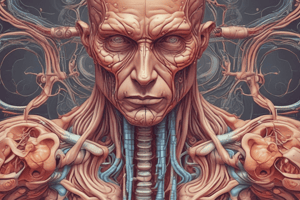Podcast
Questions and Answers
¿Qué glándula produce un fluido rico en proteínas que forma parte del semen?
¿Qué glándula produce un fluido rico en proteínas que forma parte del semen?
- Glándula prostática (correct)
- Testículos
- Epididimo
- Vesículas seminales
¿Qué proceso produce esperma en los testículos?
¿Qué proceso produce esperma en los testículos?
- Hormonogénesis
- Spermatogénesis (correct)
- Testosteronogénesis
- Espermatopoyesis
¿Qué órgano almacena y transporta esperma desde los testículos hasta el conducto deferente?
¿Qué órgano almacena y transporta esperma desde los testículos hasta el conducto deferente?
- Vas deferens
- Uretra
- Epididimo (correct)
- Conducto deferente
¿Qué hormona produce el testículo y regula la producción de esperma y las características masculinas?
¿Qué hormona produce el testículo y regula la producción de esperma y las características masculinas?
¿Qué sistema compartido por el sistema urinario y el sistema reproductivo masculino lleva semen y orina fuera del cuerpo?
¿Qué sistema compartido por el sistema urinario y el sistema reproductivo masculino lleva semen y orina fuera del cuerpo?
¿Qué eje regula la producción de esperma en los testículos?
¿Qué eje regula la producción de esperma en los testículos?
Flashcards
Testes
Testes
Glands that produce sperm through spermatogenesis and are located in the scrotum.
Epididymis
Epididymis
Stores and transports sperm from the testes.
Vas Deferens
Vas Deferens
Muscular tube that transports sperm from the epididymis to the ejaculatory ducts.
Seminal Vesicles
Seminal Vesicles
Signup and view all the flashcards
Prostate Gland
Prostate Gland
Signup and view all the flashcards
Urethra
Urethra
Signup and view all the flashcards
Study Notes
Overview
The male reproductive system is a complex system of organs and glands that work together to produce, maintain, and transport sperm.
Organs and Glands
Testes
- Produce sperm through a process called spermatogenesis
- Located outside the abdominal cavity in the scrotum
- Regulated by the hypothalamic-pituitary-testicular axis
Epididymis
- Stores and transports sperm from the testes to the vas deferens
- Located adjacent to the testes
Vas Deferens
- Muscular tube that transports sperm from the epididymis to the ejaculatory ducts
- Contraction of the vas deferens during ejaculation helps propel sperm out of the penis
Ejaculatory Ducts
- Receive sperm from the vas deferens and seminal vesicles
- Open into the urethra
Seminal Vesicles
- Produce seminal fluid, which makes up a large portion of semen
- Located adjacent to the bladder
Prostate Gland
- Produces a protein-rich fluid that makes up a portion of semen
- Surrounds the urethra and helps regulate urine flow
Urethra
- Carries semen and urine out of the body
- Shared by the urinary and reproductive systems
Hormonal Regulation
- Testosterone: produced by the testes, regulates sperm production and male characteristics
- Follicle-Stimulating Hormone (FSH): produced by the pituitary gland, stimulates sperm production
- Luteinizing Hormone (LH): produced by the pituitary gland, stimulates testosterone production
Sistema Reproductor Masculino
Órganos y Glándulas
Testículos
- Producen esperma a través del proceso de espermatogénesis
- Ubicados fuera de la cavidad abdominal en el escroto
- Regulados por el eje hipotálamo-hipófisis-testicular
Epidídimo
- Almacenan y transportan esperma desde los testículos hasta el conducto deferente
- Ubicados adyacentes a los testículos
Conducto Deferente
- Tubo muscular que transporta esperma desde el epidídimo hasta los conductos eyaculatorios
- La contracción del conducto deferente durante la eyaculación ayuda a impulsar el esperma fuera del pene
Conductos Eyaculatorios
- Reciben esperma desde el conducto deferente y vesículas seminales
- Abren en la uretra
Vesículas Seminales
- Producen fluido seminal, que forma parte del semen
- Ubicadas adyacentes a la vejiga
Glándula Prostática
- Produce un fluido rico en proteínas que forma parte del semen
- Rodea la uretra y ayuda a regular el flujo de orina
Uretra
- Transporta semen y orina fuera del cuerpo
- Compartido por los sistemas urinario y reproductivo
Regulación Hormonal
- Testosterona: producida por los testículos, regula la producción de esperma y características masculinas
- Hormona Foliculoestimulante (FSH): producida por la glándula pituitaria, estimula la producción de esperma
- Hormona Luteinizante (LH): producida por la glándula pituitaria, estimula la producción de testosterona
Studying That Suits You
Use AI to generate personalized quizzes and flashcards to suit your learning preferences.




